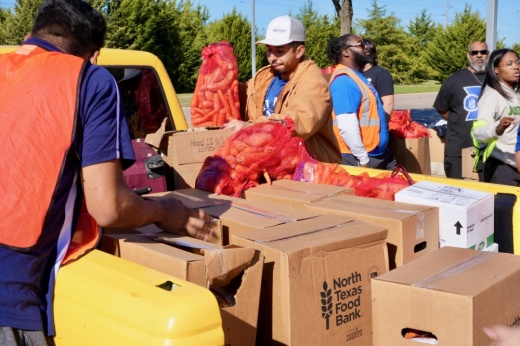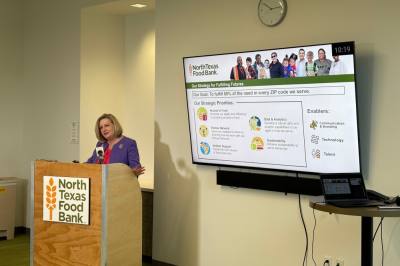In the 25 counties served by Plano-based North Texas Food Bank and Fort Worth-based Tarrant Area Food Bank, more than 1.3 million people were food insecure in 2023. That number has increased by 140,360 since 2022, NTFB officials said.
Trisha Cunningham, NTFB president and CEO, said DFW led Texas in food insecurity during 2023 and was ranked third compared to other metro areas across the country. Texas also led the nation in food insecurity for the second year in a row.
“I said this last year, and I'll say it again: this is not a badge of honor for us,” Cunningham said. “We talk about things being bigger in Texas, but this is not something that we want to have bigger in Texas.”
The setup
Cunningham broke down the latest data from Feeding America and unveiled the nonprofit’s new five-year strategic plan called "Fulfilling Futures” during a May 16 press conference. The new plan aims to build off the NTFB’s “Nourish North Texas” campaign, according to a news release.
The plan is made up of five strategic priorities with the ultimate goal of meeting at least 80% of food needs in every ZIP code served by NTFB at the end of five years. Priorities include:
- Increase agility and efficiency in providing food access
- Optimize the NTFB Partner Network
- Expand holistic approach to fighting hunger
- Improve and leverage data to meet the need
- Ensure financial sustainability
Cunningham said the NTFB will still do what it does best, but officials want to serve people in the long term by giving them access to what they need to thrive.
“We think this is really important because it’s not only those neighbors’ basic needs that are being met but they can also pursue those holistic supports that they’re going to need,” she said.
For more information about the new strategic plan, go to www.ntfb.org/fulfillingfutures
By the numbers
Dallas County makes up 61% of NTFB’s food insecure population, Cunningham said. That’s followed by Collin County which accounts for 20% of the population.
The NTFB serves 12 North Texas counties in total. About 744,370 people in its service area were food insecure in 2023 which is about a 12% increase from 2022. Approximately a third of the population are children, giving the service area a child food insecurity rate of 21.6%, according to a NTFB news release.“We’re not surprised by this,” Cunningham said of the increases. “This is what we have been serving over the past few years. We have seen needs increase overall.”
Inflated prices have made it difficult for those experiencing food insecurity to make purchasing choices between paying for rent, groceries and medicine, she said.
“Unfortunately, household incomes have not kept pace with the region’s escalating cost of living, contributing to a growing need for food assistance,” Cunningham said in a statement.
Get involved
In the last five years, the NTFB has doubled its meal distribution and distributed a record 118 million physical meals last year. Additionally, NTFB assisted individuals in accessing more than 19 million meals through the Supplemental Nutrition Assistance Program by offering application assistance.
North Texas residents can get involved with the NTFB through volunteer and donation opportunities. To learn more, go to www.ntfb.org/get-involved.






